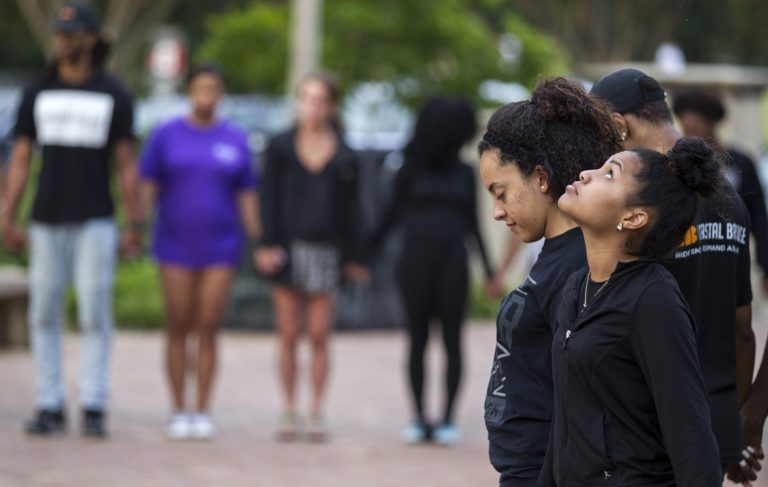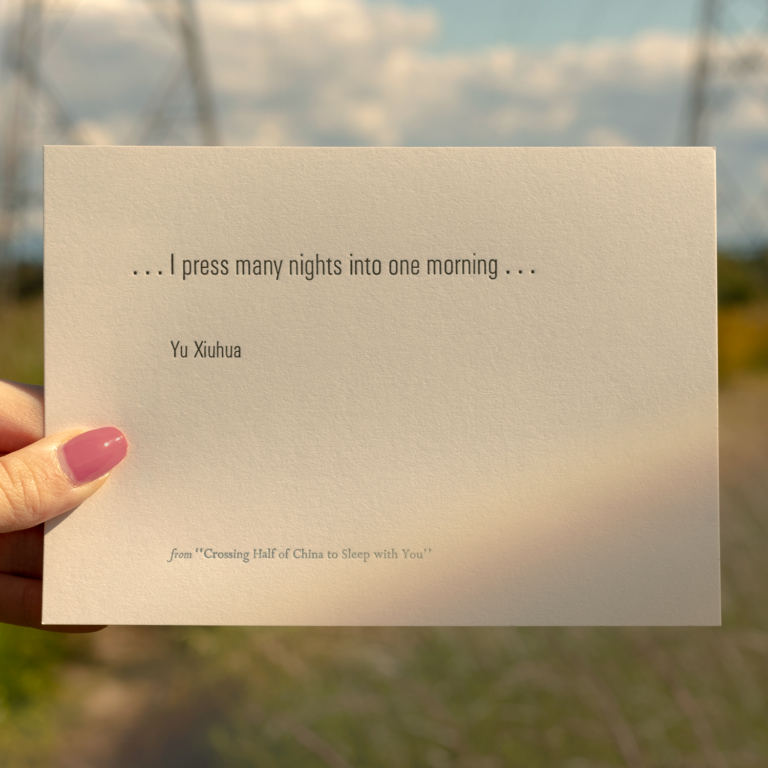
Students gather at a prayer vigil for Alton Sterling at the Memorial Tower on the Louisiana State University campus July 11, 2016 in Baton Rouge, Louisiana. Image by Mark Wallheiser.
Dwelling at the Edge, Together
When I was in middle school in the early nineties, my friends and I spent entire days, even entire weekends, roving our small rural town by foot. To reach one of our favorite spots, from the old brick Main Street we’d turn north at the grain elevator. We’d walk east along a shady paved residential road, then veer south through woods to the Missouri Pacific railroad tracks. We’d hike along the tracks until they turned into a long, high, narrow bridge across the South Fork Ninnescah River. We’d get to the middle of it, sit down, and dangle our legs.
We called the place “Stand By Me Bridge,” after the movie scene in which a cavalier boy about our age chides his wary friends into crossing a railroad bridge — and they end up running for their lives as a train barrels toward them. The movie, based on a Stephen King short story, had come out six or seven years prior and captured something about our moment as restless early adolescents in a small working-class town. We never came so close to dying as the characters in the story, but on more than one occasion we heard a train in the distance and beat it back to the dam.
I can’t say why we chose to do something so dangerous. We’d do much more dangerous things together by the time we finished high school. I do remember the quiet pressure of those moments on the bridge, a small group of girls in sandals suspended above a river with the threat of a whistling locomotive appearing from a distant curve in the tracks. While we talked about mundane things — the boys we liked, the teachers we didn’t — our bodies were electrified with adrenaline, senses heightened for the sake of survival.
This past summer felt like we, as a country, stood together at the middle of such a bridge. Between a presidential election with historic stakes, a spate of gun violence, and boiling-point cultural tensions, this season has drawn comparisons to the chaotic summer of 1968. Now, with a new school year under way and cooler weather–not to mention Election Day — approaching, we might reflect on what gifts this pressure-cooker summer offered amid tragedy and loss.
For one, I’ve noticed an increased awareness on the part of friends who don’t typically pay attention to the news. Like kids on a railroad track, they had little choice but to be alert in such a social climate. This is good news for democracy, as an apathetic or distracted populace can’t be a civically responsible one.
I’ve also observed a sense of humility in places that were previously proud or self-righteous. I don’t know anymore, people have been posting on social media, dumbfounded by yet another news story that seems too outrageous to be real. I just don’t know anymore. There is a similar reckoning with your own smallness when you feel a metal track vibrate with an approaching train — what my family would call a “come to Jesus” moment. Being humble before the vastness and depth of our country’s woes, many of which have been building for centuries, is essential for us to move forward.
In nature and in life, pressure is often what propels change — turning coal to diamonds, encouraging people in difficult situations to work hard toward better dreams. While sometimes painful, that tension is less about a fleeting summer than it is a never-ending feature of our existence. As the poet Sandra Gilbert shows in her 1982 poem “Blood Pressure,” the force of life itself can be at once horrible and essential, awesome and unbearable:
How it pounds in you, how it
urges through you, how it asserts
its power like a tide of electronsflashing through your veins, shocking your fingertips,
exhausting the iron gates of your heart.
Alive, alive, always alive, it hisses,crackling like the lightning snake that splits
the sky at evening, alive, a black rain
lashing the hollows of your body,Alive, alive.
To sit in a place of simultaneous promise and burden with some semblance of balance is the art of life — the inherent friction a precursor to growth. This past summer, in both tragic and inspiring ways, we dwelled at that edge together. What comes next, we can hope, will bring a sense of relief.
Texas, where I now live, like much of the country spent all summer inside a “heat dome” — a high-pressure lid in the upper atmosphere that kept warm air from escaping. We endured a crescendo of dangerous temperatures for weeks. I have a strong tolerance for heat, but even I had to take a screenshot of my weather app reporting a heat index of 117 degrees on August 12. A couple days later, it was pouring rain and I was reaching for my jacket for the first time in months. It felt glorious, the pressure in the air finally having dissipated, the dry, cracked earth finally dampened and cooled.
The kids in the famous Stand By Me scene experienced profound relief when they made it to the end of the railroad bridge and jumped off the tracks. They’d felt their hearts pound in their chests, they’d felt their feet pound against the railroad ties, they’d heard the train right behind them drowning out their own screams at one another to run. It was a hell of a thing to get through, but once they did, their bond was tighter for it. Like the pleasure of rain after weeks of dry heat, there was some reward for what they’d survived.
We can bet that the conflicts and tensions of this American summer will always be with us, in some form. Before they ebb, they may continue to mount until Election Day and beyond. We can hope, though, that they’re propelling us toward positive change. We can stay alert, be humbled by the fragility of even a strong nation, and take whatever action is available to ensure that the powerful transformation upon us is ultimately for the good.


Share your reflection